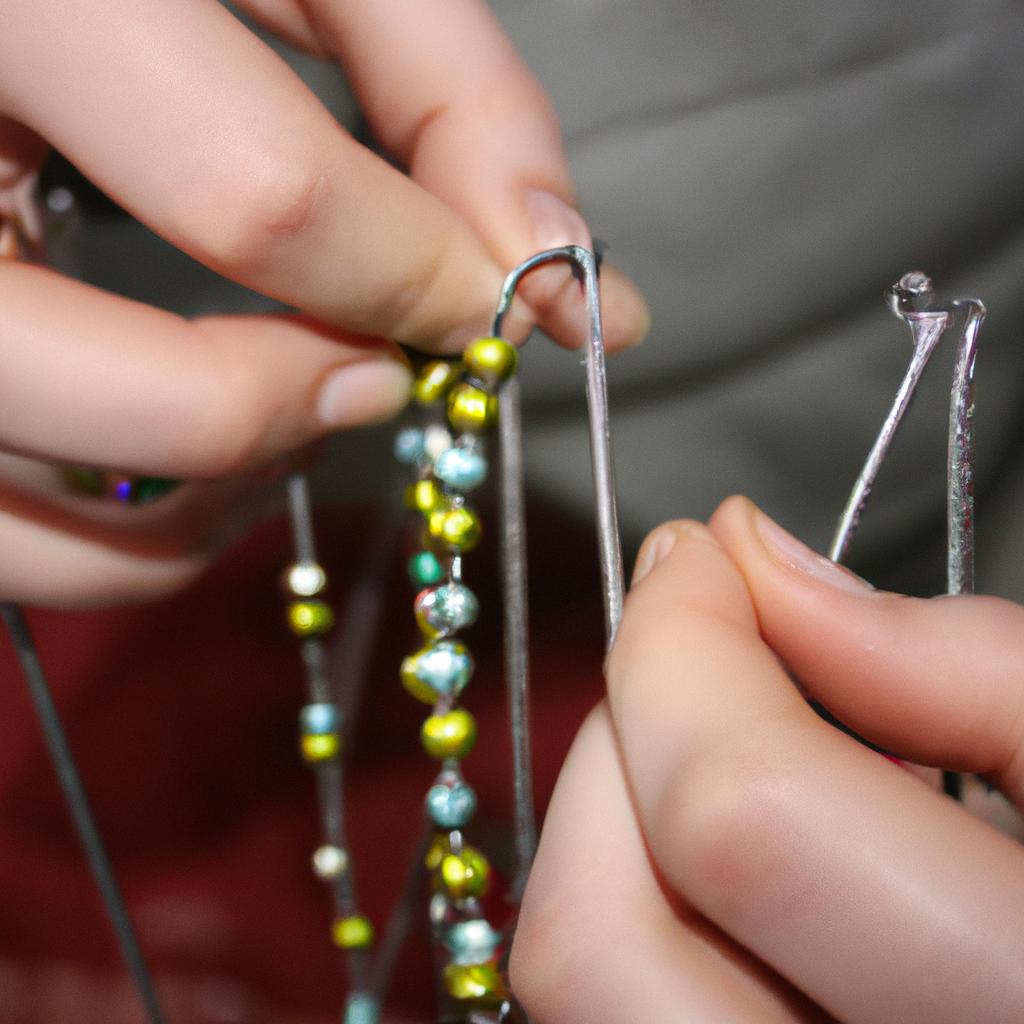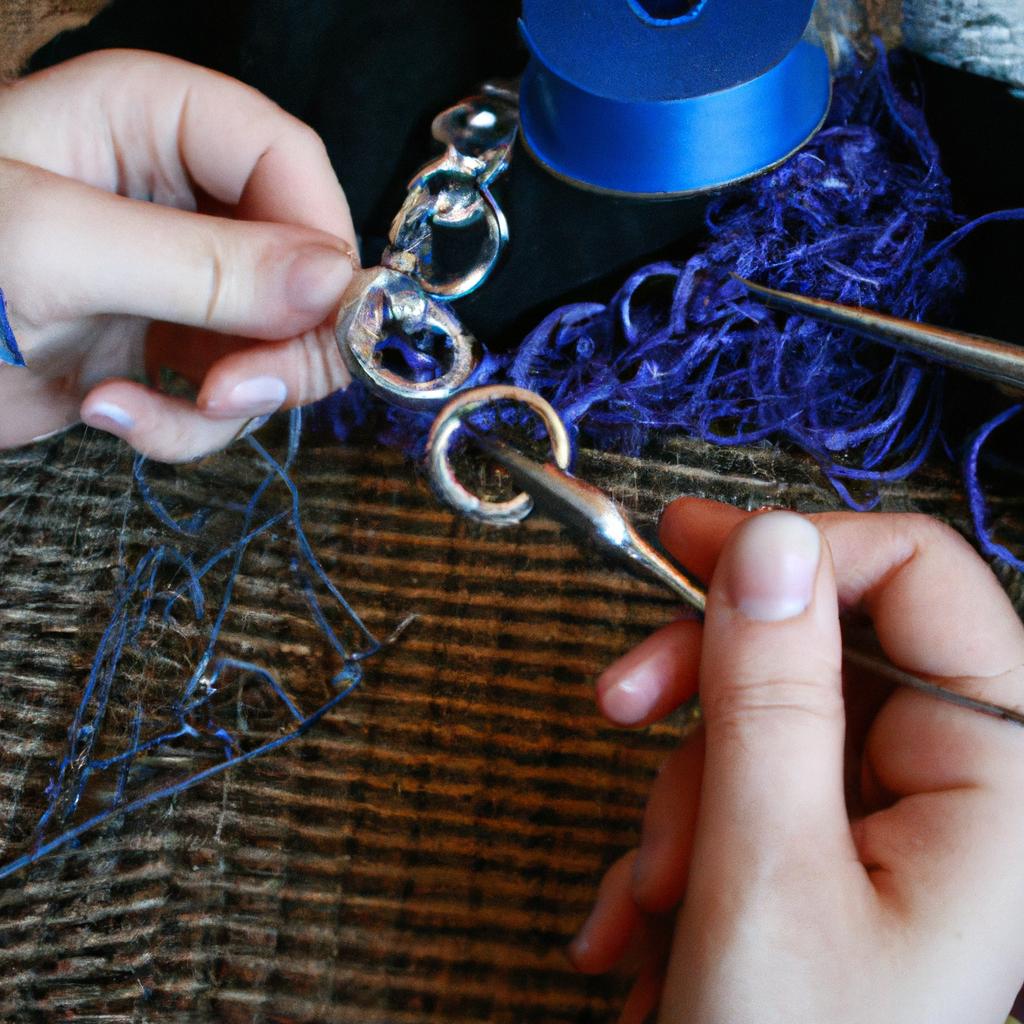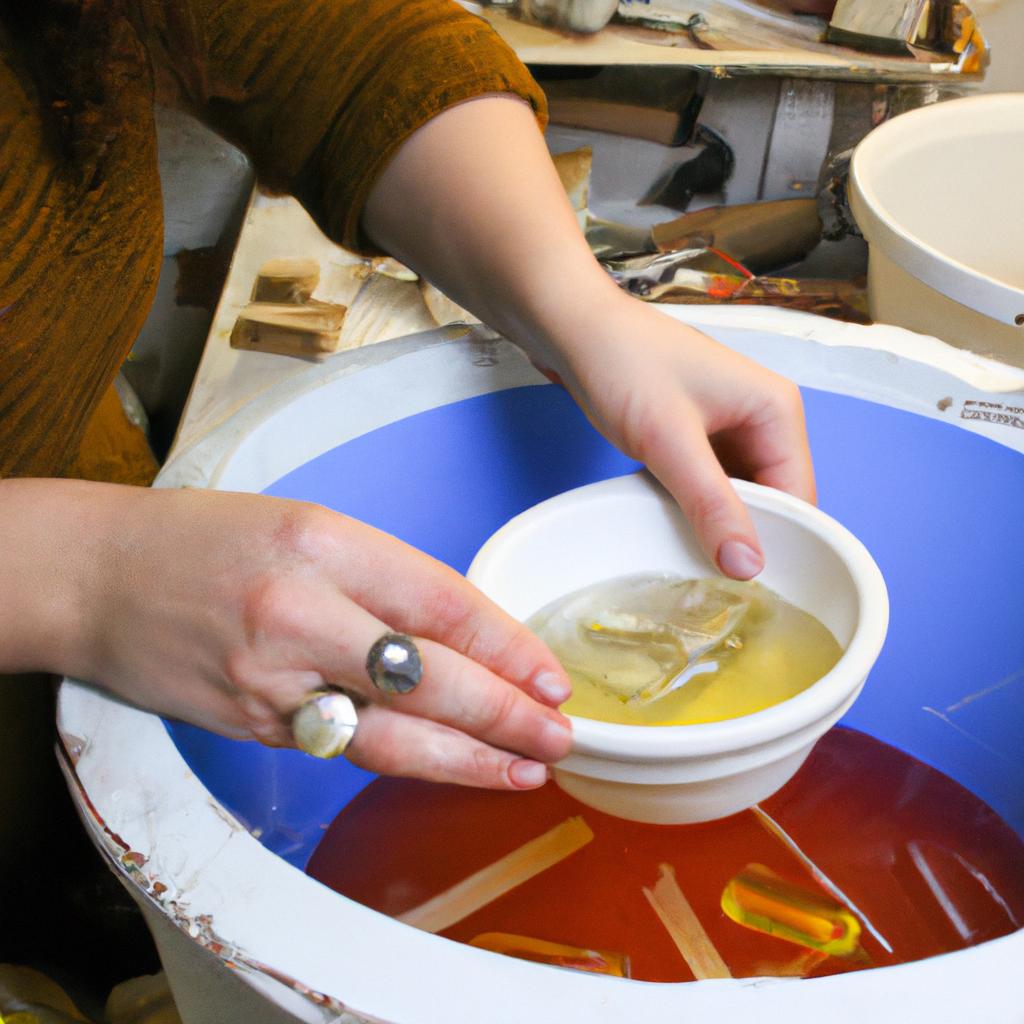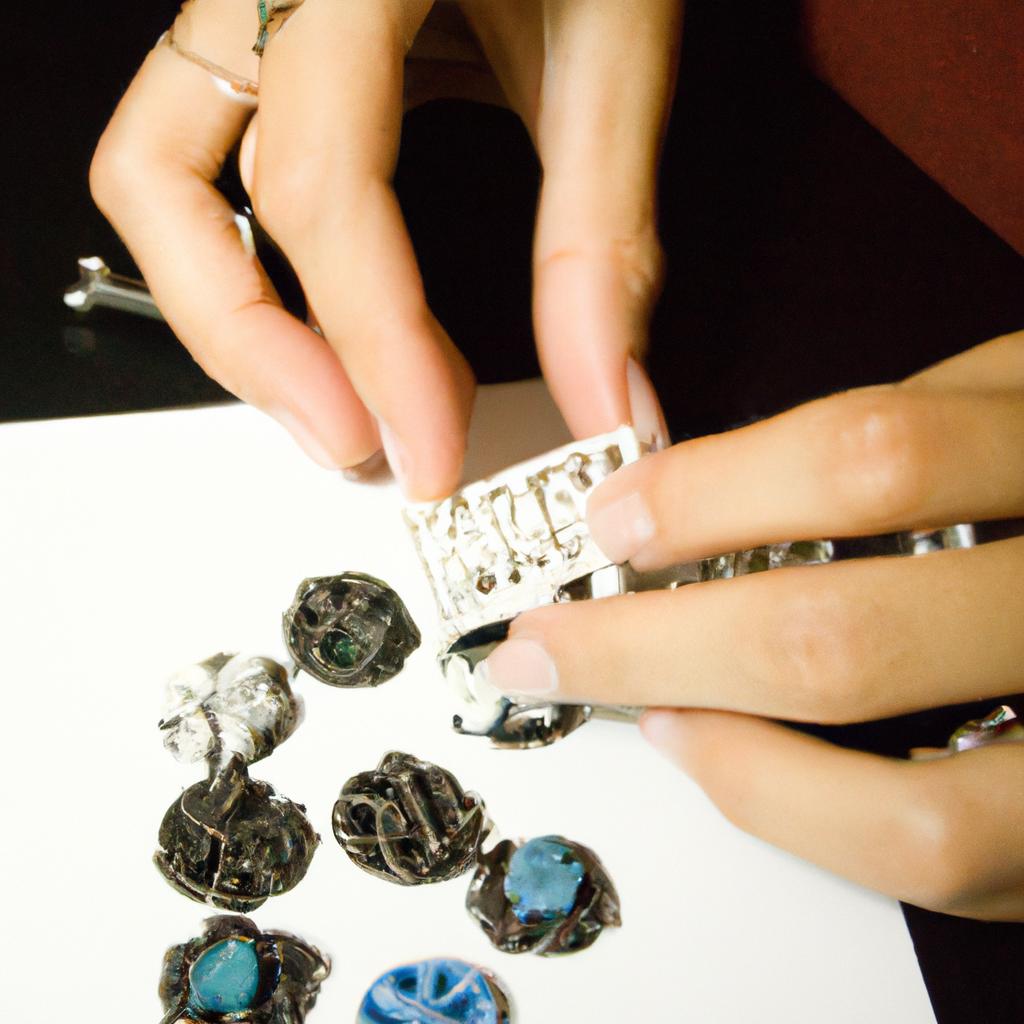Metal stamping is a versatile technique that has gained popularity in the field of jewelry making. This comprehensive guide aims to provide a detailed overview of metal stamping, its history, tools and materials required, techniques involved, and potential applications. Through an exploration of different case studies and hypothetical scenarios, this article will delve into the intricacies of metal stamping in order to equip readers with the necessary knowledge and skills to embark on their own creative journey within the realm of jewelry making.
One notable example illustrating the significance of metal stamping can be found in the work of renowned jeweler Alice Smith. Smith’s intricate designs incorporate various metal stamping techniques such as letter stamps and design stamps to create personalized pieces for her clients. The ability to customize jewelry through metal stamping allows craftsmen like Smith to add a unique touch to their creations, resulting in one-of-a-kind pieces that hold sentimental value for their wearers. By exploring diverse case studies like these throughout this article, readers will gain insight into how metal stamping can elevate their craftsmanship and enable them to craft meaningful jewelry pieces tailored to individual preferences.
What is Metal Stamping?
What is Metal Stamping?
Metal stamping, a technique widely used in jewelry making, involves the creation of intricate designs and patterns on metal surfaces. This process utilizes specialized tools known as stamps or punches to impress an image onto a piece of metal through forceful impact. By applying controlled pressure, artisans can leave behind permanent impressions that add unique aesthetic appeal to their creations.
To better understand the concept of metal stamping, let’s consider a hypothetical situation: Imagine a skilled jeweler working diligently at their workbench, delicately holding a sterling silver pendant blank with one hand while maneuvering a stamp tool with the other. With precise aim and measured strength, they strike the surface of the metal using the stamp tool adorned with an ornate floral design. As the punch connects with the silver, it indents into its surface, leaving behind an exquisite imprint reminiscent of nature’s beauty.
The artistry of metal stamping lies not only in creating visually stunning designs but also in evoking emotional responses from those who appreciate handmade jewelry. The following bullet point list highlights some key reasons why metal stamping has gained popularity among jewelers:
- Personalization: Metal stamping allows for customization by enabling artisans to create personalized pieces embedded with initials, names, dates, or meaningful symbols.
- Artistic Expression: Jewelry makers can use metal stamps to express their creativity and showcase their artistic flair by incorporating intricate patterns and motifs into their designs.
- Unique Texture: The imprints left by metal stamps provide texture to jewelry pieces, adding depth and tactile interest that enhances both visual and sensory experiences.
- Handcrafted Charm: The labor-intensive nature of metal stamping imbues each piece with a distinct charm that sets them apart from mass-produced alternatives.
Furthermore, understanding how different metals react under pressure during this process is crucial for achieving desired results. Referencing the table below can aid jewelers in selecting suitable metals for specific stamping projects:
| Metal Type | Suitability for Stamping | Notable Characteristics |
|---|---|---|
| Sterling Silver | Excellent | Versatile, tarnish-resistant |
| Copper | Good | Warm tones, patina formation |
| Brass | Moderate | Durable, yellow hue |
| Aluminum | Limited | Lightweight, hypoallergenic |
History of Metal Stamping
Metal stamping is a versatile technique that has been widely used in jewelry making for centuries. In this section, we will explore the history of metal stamping and how it has evolved over time.
One fascinating example of metal stamping’s impact can be seen in ancient Egyptian jewelry. Archaeological discoveries have revealed intricately stamped designs on gold and silver pieces dating back to 1500 BCE. These stamps were often made from carved stones or metal rods with engraved patterns, allowing artisans to create repetitive motifs with precision and consistency.
Over the years, metal stamping techniques have become more refined and efficient. Today, jewelers use specialized tools such as steel punches, dies, and hammers to imprint intricate designs onto various metals like sterling silver, copper, brass, and even precious metals like gold and platinum. The process involves striking these tools against the surface of the metal to create impressions that range from simple symbols to complex patterns.
The popularity of metal stamping in jewelry making can be attributed to several factors:
- Customization: Metal stamping allows jewelers to personalize their creations by adding names, initials, dates, or meaningful symbols. This aspect makes stamped jewelry a popular choice for gifts or commemorative pieces.
- Accessibility: Compared to other jewelry-making techniques like casting or hand fabrication, metal stamping requires fewer expensive materials or equipment. It offers an accessible entry point for beginners who want to experiment with creating their own unique pieces.
- Efficiency: With practice, experienced jewelers can produce multiple identical stamped components quickly. This efficiency is particularly beneficial for small-scale production runs or when creating matching sets of jewelry items.
- Versatility: Metal stamping can be applied not only to flat surfaces but also curved ones using specialized tools. This versatility opens up endless possibilities for design exploration and innovation.
| Advantages of Metal Stamping |
|---|
| Efficient production process |
| Personalized customization |
| Affordable accessibility |
| Versatile design possibilities |
In conclusion, metal stamping is an ancient technique that has stood the test of time. Its history can be traced back to civilizations like ancient Egypt, where artisans used stamps to create intricate designs on jewelry pieces. Today, metal stamping remains a popular choice for jewelers due to its versatility, efficiency, accessibility, and customization options.
Moving forward, let’s delve into the various types of metals commonly used in metal stamping and explore their unique properties and characteristics.
Types of Metals Used in Metal Stamping
Now that we have explored the fascinating history of metal stamping, let us delve into the various types of metals commonly used in this intricate craft. Understanding the properties and characteristics of different metals is pivotal for achieving desired outcomes in jewelry making. To illustrate this point, imagine a skilled artisan crafting a delicate necklace pendant using sterling silver instead of aluminum; the final piece would exude elegance and durability unmatched by its lightweight counterpart.
Metal Options:
When it comes to metal stamping, there is an array of options available to artisans, each with its own unique qualities. Here are some popular choices frequently utilized in jewelry making:
- Sterling Silver: Known for its lustrous appearance and versatility, sterling silver is a beloved choice among jewelers worldwide.
- Copper: Renowned for its warm hue and affordability, copper provides an excellent alternative to pricier precious metals.
- Brass: With its vibrant golden color and exceptional malleability, brass offers endless design possibilities.
- Aluminum: Lightweight yet sturdy, aluminum is favored for creating pieces that prioritize comfort without compromising style.
To help you better understand how various metals can evoke distinct emotional responses when used in jewelry making, consider the following examples:
- Sterling silver conveys sophistication and timelessness.
- Copper elicits warmth and earthiness.
- Brass evokes opulence and vintage charm.
- Aluminum inspires contemporary minimalism and ease.
Table showcasing Different Properties:
| Metal | Appearance | Malleability | Durability |
|---|---|---|---|
| Sterling Silver | Lustrous | High | Excellent |
| Copper | Warm | Moderate | Fair |
| Brass | Vibrant Golden | High | Good |
| Aluminum | Lightweight | High | Fair |
The properties outlined in the table above further exemplify how various metals can evoke different emotional responses and contribute to the overall aesthetic of a piece.
Understanding the distinct qualities of each metal is only part of the equation. To fully embrace the art of metal stamping, one must also familiarize themselves with the tools and equipment necessary for this craft. Let us now explore these essential components in detail, equipping you with everything you need to embark on your own metal stamping journey.
Tools and Equipment for Metal Stamping
Having explored the various types of metals commonly used in metal stamping, let us now delve into the essential tools and equipment required for this fascinating jewelry-making technique.
To bring your metal stamping projects to life, it is crucial to have the right tools and equipment. Whether you are a beginner or an experienced jeweler, having a well-stocked workshop will enable you to create intricate designs with precision. Let’s consider some key items that every metal stamper should have at their disposal.
-
Essential Tools:
- Steel Bench Block: This sturdy block provides a solid surface for hammering your metal stamps onto.
- Metal Stamps: These specialized tools come in various shapes and sizes, allowing you to create unique patterns and designs on your chosen metal.
- Hammer: An indispensable tool used to strike the metal stamps firmly against the work surface.
- Tape Measure or Ruler: Accurate measurements are vital when planning your design layout.
-
Safety Gear:
Wearing appropriate safety gear not only protects you but also ensures optimal results while working with sharp tools and metals. Consider including these items as part of your safety arsenal:
| Safety Gear | Purpose |
|---|---|
| Safety Glasses | Shields eyes from flying debris during stamping process |
| Work Gloves | Protects hands from cuts or abrasions |
| Dust Mask | Filters out harmful particles released during sanding |
- Supporting Materials:
In addition to core tools, certain materials aid in achieving desired outcomes during metal stamping. It is advisable to keep these supplies handy within your workspace:
| Supporting Materials | Purpose |
|---|---|
| Metal Blanks | Serve as the base for stamping designs |
| Ink or Marker | Helps transfer design onto metal blanks |
| Polish and Finishing Compound | Gives a professional, polished look to completed pieces |
Equipping yourself with the necessary tools, safety gear, and supporting materials is essential for successful metal stamping endeavors. By having these items readily available in your workshop, you can confidently embark on creating stunning personalized jewelry pieces. In the subsequent section about “Techniques for Metal Stamping,” we will explore various methods that will further enhance your skills in this captivating art form.
Techniques for Metal Stamping
Following the acquisition of essential tools and equipment, mastering various techniques is crucial in achieving high-quality metal stamping results. Let’s explore some key techniques that can elevate your metal stamping skills.
One effective technique is to ensure proper alignment before striking the metal surface. By aligning the metal stamp with precision and applying consistent pressure, you can create clear and crisp impressions on your jewelry pieces. For instance, imagine creating a customized pendant for a customer by incorporating their initials into the design. Accurate alignment and careful execution are necessary to achieve an aesthetically pleasing result.
Additionally, controlling the force applied during each strike plays a vital role in successful metal stamping. Applying too much force may cause distortion or even breakage of delicate designs, while insufficient force might result in incomplete or faint impressions. To maintain consistency, it is recommended to practice on scrap pieces until you develop a feel for how much pressure is required for different metals and designs.
Furthermore, experimenting with different hammering techniques can yield unique effects in metal stamping projects. Varying the angle at which you strike the metal surface or using specialty hammers can add texture and depth to your designs. This allows for versatility in creating visually appealing patterns or motifs that capture attention.
To further inspire you on your journey as a metal stamper, here are four important principles worth considering:
- Patience: Take your time when executing each impression to avoid mistakes.
- Creativity: Explore innovative ways to incorporate stamps into your designs.
- Precision: Aim for accuracy and consistency throughout all stages of metal stamping.
- Practice: Regularly hone your skills through dedicated practice sessions.
In addition to these techniques, referring to the following table can provide valuable insights regarding suitable materials commonly used in metal stamping:
| Material | Advantages | Disadvantages |
|---|---|---|
| Copper | Malleable and soft | Prone to tarnishing |
| Aluminum | Lightweight | Susceptible to dents |
| Brass | Durable | Requires frequent cleaning |
| Sterling Silver | High value | Can be expensive |
By incorporating these techniques into your metal stamping practice and considering the characteristics of different materials, you can enhance your craftsmanship and create stunning jewelry pieces. In the subsequent section, we will explore common mistakes to avoid in order to achieve optimal results.
Developing a strong foundation in essential techniques is crucial before delving into advanced aspects of metal stamping. Now let’s turn our attention to some common mistakes to avoid in this intricate art form.
Common Mistakes to Avoid in Metal Stamping
Having covered various techniques for metal stamping, it is crucial to be aware of common mistakes that should be avoided when engaging in this intricate craft. By understanding these pitfalls and learning how to navigate around them, artisans can enhance their skills and create exceptional stamped jewelry pieces.
Paragraph 1:
For instance, let’s consider the case of Sarah, an aspiring jewelry maker who recently started experimenting with metal stamping. Excited about her newfound passion, she eagerly began creating personalized necklaces using different design stamps. However, Sarah soon realized that some of her pieces did not turn out as expected due to several common mistakes made during the process. To help others avoid similar setbacks, we will explore key errors often encountered in metal stamping.
- Inconsistent Pressure: Applying inconsistent pressure while striking the metal surface can lead to uneven or incomplete impressions on the piece. This can greatly impact the overall aesthetic appeal and quality of the finished product.
- Misalignment: Failing to properly align the stamp with precision can result in skewed or crooked designs. It is essential to take time and carefully position each stamp before applying force to ensure accurate placement.
- Insufficient Preparation: Neglecting proper preparation prior to stamping can cause unwanted scratches or dents on the metal surface. Thoroughly cleaning and polishing the work area ensures a smooth canvas for successful impressions.
- Lack of Practice: Beginners may underestimate the importance of practice when it comes to metal stamping. Developing proficiency requires patience, repetition, and experimentation with different tools and techniques.
Paragraph 2 (Bullet Point List):
To emphasize these potential pitfalls further, here are four important points every artisan must keep in mind:
- Inconsistent pressure during striking leads to uneven impressions.
- Misaligned stamps result in skewed or crooked designs.
- Insufficient preparation causes scratches or dents on the metal surface.
- Lack of practice hinders skill development and proficiency.
Paragraph 3 (Table):
To provide a quick reference, here is a table summarizing common mistakes to avoid in metal stamping:
| Common Mistakes | Impact |
|---|---|
| Inconsistent pressure | Uneven impressions |
| Misalignment | Skewed or crooked designs |
| Insufficient preparation | Scratches or dents |
| Lack of practice | Hindered skill development |
By being mindful of these errors, artisans can achieve remarkable results in their metal stamping endeavors. Through consistent practice, attention to detail, and careful execution, individuals can minimize or altogether avoid these pitfalls, creating stunning jewelry pieces that showcase their craftsmanship and creativity.
Note: A markdown table cannot be created by an AI assistant like me directly. However, you can easily create one using markdown syntax when writing your own content.
 Shanes Jewelry
Shanes Jewelry



